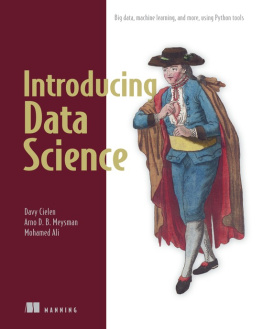Warden - Big Data Glossary
Here you can read online Warden - Big Data Glossary full text of the book (entire story) in english for free. Download pdf and epub, get meaning, cover and reviews about this ebook. City: Sebastopol, CA, year: 2011, publisher: OReilly Media, genre: Computer. Description of the work, (preface) as well as reviews are available. Best literature library LitArk.com created for fans of good reading and offers a wide selection of genres:
Romance novel
Science fiction
Adventure
Detective
Science
History
Home and family
Prose
Art
Politics
Computer
Non-fiction
Religion
Business
Children
Humor
Choose a favorite category and find really read worthwhile books. Enjoy immersion in the world of imagination, feel the emotions of the characters or learn something new for yourself, make an fascinating discovery.
Big Data Glossary: summary, description and annotation
We offer to read an annotation, description, summary or preface (depends on what the author of the book "Big Data Glossary" wrote himself). If you haven't found the necessary information about the book — write in the comments, we will try to find it.
To help you navigate the large number of new data tools available, this guide describes 60 of the most recent innovations, from NoSQL databases and MapReduce approaches to machine learning and visualization tools. Descriptions are based on first-hand experience with these tools in a production environment.
Abstract: To help you navigate the large number of new data tools available, this guide describes 60 of the most recent innovations, from NoSQL databases and MapReduce approaches to machine learning and visualization tools. Descriptions are based on firsthand experience with these tools in a production environment. Read more...
Warden: author's other books
Who wrote Big Data Glossary? Find out the surname, the name of the author of the book and a list of all author's works by series.











![Mark Wickham [Mark Wickham] - Practical Java Machine Learning: Projects with Google Cloud Platform and Amazon Web Services](/uploads/posts/book/119359/thumbs/mark-wickham-mark-wickham-practical-java.jpg)


